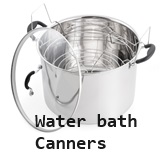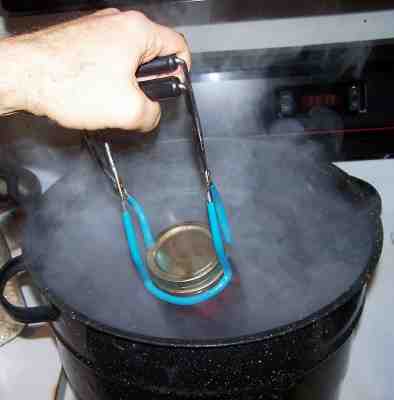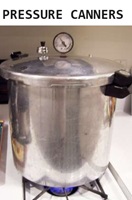
Looking for How to Make Kiwi Jam - Easily! With Step-by-step Directions, Photos, Ingredients, Recipe and Costs in 2025? Scroll down this page and follow the links. And if you bring home some fruit or vegetables and want to can, freeze, make jam, salsa or pickles, see this page for simple, reliable, illustrated canning, freezing or preserving directions. There are plenty of other related resources, click on the resources dropdown above. If you are having a hard time finding canning lids, I've used these, and they're a great price & ship in 2 days.
If you have questions or feedback, please let me know! There are affiliate links on this page. Read our disclosure policy to learn more.
How to Make Kiwi Jam - Easily! With Step-by-step Directions, Photos, Ingredients, Recipe and Costs
Yield: 4 half pint (8 oz) jars
Click here for a PDF print version
Kiwi jam is an easy way to enjoy kiwi's all year round! Making and canning your own
kiwi jam or preserves is much easier than you realize. This recipe is based on
the Ball Blue Book for reliability and safety! 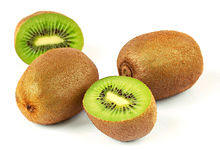
Ingredients
- Fruit - 3 cups peeled, chopped ripe kiwi. That's about 12 fresh kiwi's (they vary in size, so it could be 8 to 15)
- Pectin ("no sugar needed" type) - I use 1 and 1/3 boxes of pectin - (it's a natural product, made from apples and available at grocery stores (season - spring through late summer) and local "big box" stores. It usually goes for about $2.00 to $2.50 per box. You will get best results with no-sugar needed pectin, whether you choose to add sugar or not! See here for more information about how to choose the type of pectin to use.
- Pineapple juice - 1 cup unsweetened pineapple juice
- Sugar - About 4 cups of dry, granulated (table) sugar. At least 1 large pot; I prefer 16 to 20 quart Nonstick ceramic coated pots for easy cleanup.
Equipment
- Large spoons and ladles,
- 1 Water Bath Canner (a huge pot to sanitize the jars after filling (about $30 to $35 at mall kitchen stores, sometimes at big box stores and grocery stores.). Note: we sell canners and supplies here, too - at excellent prices - and it helps support this web site!
- Half pint canning jars (Grocery stores, like Publix, Kroger, Safeway carry them, as do some big box stores - about $7 per dozen 8 ounce jars including the lids and rings)
- Lids - thin, flat, round metal lids with a gum binder that seals them against the top of the jar. They may only be used once.
- Rings - metal bands that secure the lids to the jars. They may be reused many times.
- Jar funnel ($5 at Target, other big box stores, and often grocery stores; and available online - see this page) or order it as part of the kit with the Jar grabber .
- Lid lifter (has a magnet to pick the lids out of the almost-boiling water where you sanitize them. ($4 at big box stores or it comes in the kit at left)
- Jar grabber (to pick up the hot jars)- Big box stores and grocery stores sometimes carry them; and it is available online - see this page. It's a tremendously useful to put jars in the canner and
take the hot jars out (without scalding yourself!). The kit sold
below has everything you need, and at a pretty good price:
See here for related tools, equipment, supplies on Amazon
Optional stuff:
Directions - Step by Step
Step 1 - Select and wash the fruit
Select ripe, but not overripe, unbruised kiwis. Wash the, in cold water, then peel them, and chop them into 1/2 inch sized pieces.
Step 2 - Wash the jars and lids
Canning jars in the dishwasherNow's a good time to get the jars ready, so you won't be rushed later. The dishwasher is fine for the jars; especially if it has a "sanitize" cycle, the water bath processing will sanitize them as well as the contents! If you don't have a dishwasher with a sanitize cycle, you can wash the containers in hot, soapy water and rinse, then sanitize the jars by boiling them 10 minutes, and keep the jars in hot water until they are used.
NOTE: If a canning recipe calls for 10 minutes or more of process time in the canner, then the jars do not need to be "sanitized" before filling them. But really, sanitizing them first is just good hygeine and common sense! See this page for more detail about cleaning and sanitizing jars and lids.
Put the lids into a pan of hot, but not quite boiling water (that's what the manufacturer's recommend) for 10 minutes, and use the magnetic "lid lifter wand" to pull them out. Leave the jars in the dishwasher on "heated dry" until you are ready to use them. Keeping them hot will prevent the jars from breaking when you fill them with the hot jam.
Step 3 - Get the lids warming in hot (but not boiling) water
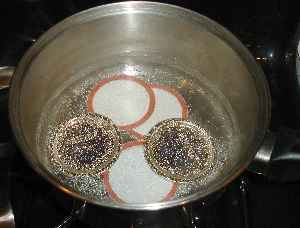 Lids: put the lids into a pan of
hot water for at least several minutes; to soften up the gummed surface
and clean the lids.
Lids: put the lids into a pan of
hot water for at least several minutes; to soften up the gummed surface
and clean the lids.
Need lids, rings and replacement jars?
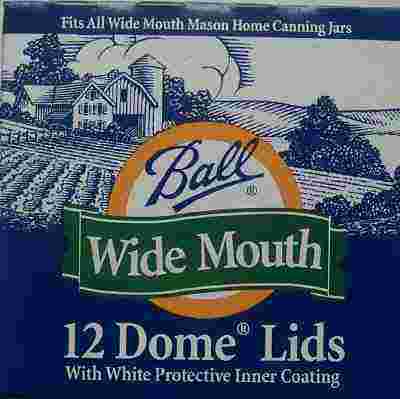
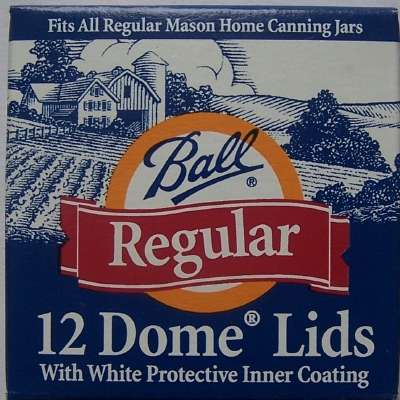
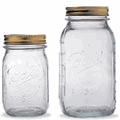 Get them all here, delivered direct to your home, at the best prices on the internet!
Get them all here, delivered direct to your home, at the best prices on the internet!
Step 4 - Measure out the sugar and pectin
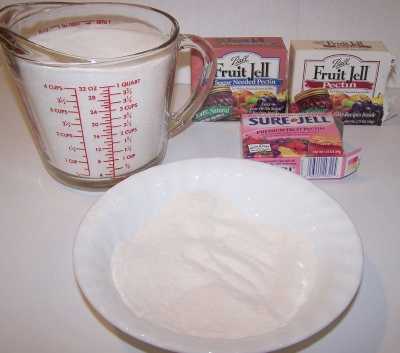 You will need 4 cups of sugar.
Yes, you can use honey or organic sugars instead. If you want to use a
heat-stable sugar substitute (Stevia (in a prepared form like Truvia, it measures same as sugar; if you use another form, you will need do your own conversion) - or Splenda, if you prefer, , Stevia), you may, but the results
will not be nearly as good (darker, flatter tasting, more runny). You
can use half sugar and half sugar substitute with pretty good results. But
don't kid yourself that jam is health food! Just don't eat a lot of
it!
You will need 4 cups of sugar.
Yes, you can use honey or organic sugars instead. If you want to use a
heat-stable sugar substitute (Stevia (in a prepared form like Truvia, it measures same as sugar; if you use another form, you will need do your own conversion) - or Splenda, if you prefer, , Stevia), you may, but the results
will not be nearly as good (darker, flatter tasting, more runny). You
can use half sugar and half sugar substitute with pretty good results. But
don't kid yourself that jam is health food! Just don't eat a lot of
it!
Mix the dry pectin with about 1/4 cup of sugar and Keep this separate from the rest of the sugar. If you are not using sugar, you will just have to stir more vigorously to prevent the pectin from clumping. This helps to keep the pectin from clumping up and allows it to mix better!
Step 5 - Mix the kiwis and pineapple juice with the pectin and heat to a full boil
Stir the pectin into the kiwis and put the mix in a big pot on the stove over medium to high heat (stir often enough to prevent burning). It should take about 5 to 10 minutes to get it to a full boil (the kind that cannot be stirred away).
Notes about pectin: I usually add about 25% - 30% more pectin (just open another pack and add a little) or else the jam is runnier than I like. With a little practice, you will find out exactly how much pectin to get the thickness you like.
Another tip: use the No-sugar pectin - it works better and allows you to use less sugar, and you can stilln add sugar to it. Either way, it cuts the amount of sugar you need from 7 cups per batch to 4 cups! And it tastes even better! On the other hand; I have never had success with the No-sugar pectin without adding ANY sugar. It always turned out runny and bland. You might want to try using the low sugar recipe with a mixture of sugar and Stevia (in a prepared form like Truvia, it measures same as sugar; if you use another form, you will need do your own conversion) - or Splenda, if you prefer, ; that could work.

Is your jam too runny? Pectin enables you to turn out perfectly set jam every time. Made from natural apples, there are also natural no-sugar pectins that allow you to reduce the sugar you add by half or even eliminate sugar!
Get them all here at the best prices on the internet!
Step 6 - Add the remaining sugar and bring to a boil
When
the berry-pectin mix has reached a full boil, add the rest of the sugar
(about 4 cups of sugar per batch of kiwis) or other sweetener, and
then bring it back to a boil and boil hard for 1 minute.
Step 7 - Testing for "jell" (thickness)
I keep a metal tablespoon sitting in a
glass of ice water, then take a half spoonful of the mix and let it cool
to room temperature on the spoon. If it thickens up to the
consistency I like, then I know the jam is ready. If not, I mix in a
little more pectin (about 1/4 to 1/2 of another package) and bring it to a
boil again for 1 minute.
Step 8 - Optional: Let stand for 5 minutes and stir completely.
Why? Otherwise, the fruit will often float to the top of the jar. This isn't a particular problem; you can always stir the jars later when you open them; but some people get fussy about everything being "just so", so I've included this step! Skipping this step won't affect the quality of the jam at all. You will also notice that the less sugar you use, the more the fruit will float (chemists will tell you it is due to the decreased density of the solution!)
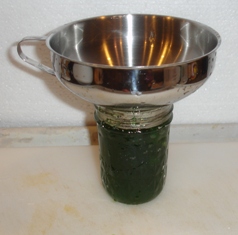 Step
9 - Fill the jars and put the lid and
rings on
Step
9 - Fill the jars and put the lid and
rings on
Fill them to within 1/4-inch of the top, wipe any spilled jam off the top, seat the lid and tighten the ring around them. Then put the filled jars into the canner!
This is where the jar tongs come in really handy!
Step 10 - Process the jars in the boiling water bath
Keep the jars covered with at least 2 inches of water. Keep the water
boiling. In general, boil them for 10 minutes, which is what SureJell (the
makers of the pectin) recommend. I say "in general"
because you have to
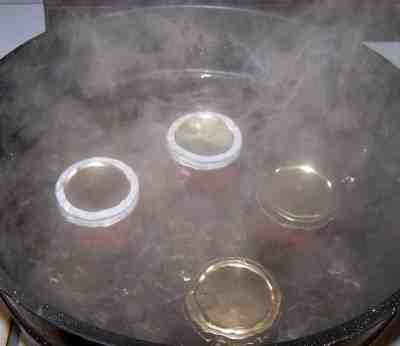 process (boil) them longer at higher altitudes than sea
level, or if you use larger jars, or if you did not sanitize the jars and
lids right before using them. The directions inside every box of
pectin will tell you exactly. The directions on the pectin tend to be
pretty conservative. Clemson University says you only need to process
them for 5 minutes. I usually hedge my bets and start pulling them out
after 5 minutes, and the last jars were probably in for 10. I rarely
have a jar spoil, so it must work. But you don't want to process them too
long, or the jam will turn dark and get runny. See the chart
below for altitude adjustment to processing times, if you are not in the sea
level to 1,000ft above sea level range.
process (boil) them longer at higher altitudes than sea
level, or if you use larger jars, or if you did not sanitize the jars and
lids right before using them. The directions inside every box of
pectin will tell you exactly. The directions on the pectin tend to be
pretty conservative. Clemson University says you only need to process
them for 5 minutes. I usually hedge my bets and start pulling them out
after 5 minutes, and the last jars were probably in for 10. I rarely
have a jar spoil, so it must work. But you don't want to process them too
long, or the jam will turn dark and get runny. See the chart
below for altitude adjustment to processing times, if you are not in the sea
level to 1,000ft above sea level range.
Note: Some people don't even boil the jars; they just ladle it hot into hot jars, put the lids and rings on and invert them, but putting the jars in the boiling water bath REALLY helps to reduce spoilage! To me, it makes little sense to put all the working into making the jam and then not to process the jars to be sure they don't spoil!
|
Recommended process time for jams in a boiling water canner. |
||||
| Process Time at Altitudes of | ||||
| Style of Pack | Jar Size | 0 - 1,000 ft | 1,001 - 6,000 ft | Above 6,000 ft |
| Hot | Half-pints or Pints |
5 min | 10 | 15 |
Step 11 - Remove and cool the jars - Done!
Lift the jars out of the water with your jar lifter tongs and let them cool without touching or
bumping them in a draft-free place (usually takes overnight) You can then remove the rings if you like, but if you leave them on, at least loosen them quite a bit, so they don't rust in place due to trapped moisture. Once the jars are cool, you can check that they are sealed verifying that the lid has been sucked down. Just press in the center, gently, with your finger. If it pops up and down (often making a popping sound), it is not sealed. If you put the jar in the refrigerator right away, you can still use it. Some people replace the lid and reprocess the jar, then that's a bit iffy. If you heat the contents back up, re-jar them (with a new lid) and the full time in the canner, it's usually ok.
Once cooled, they're ready to store. I find they last up to 12 months. But after about 6 to 8 months, they get darker in color and start to get runny. They still are safe to eat, but the flavor and texture aren't as good. So eat them in the first 6 months after you prepare them! Another trick is to keep the uncooked kiwis or other fruit in the freezer and make and can the jam as needed, so it's always fresh.
Other Equipment:From left to right:
|
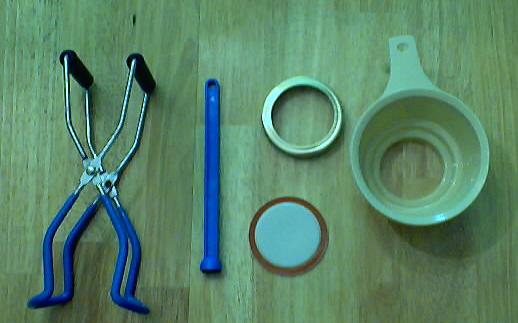 You can get all of the tools in a kit here: See here for related tools, equipment, supplies on Amazon |
Summary - Typical Cost of Making Homemade Kiwi Jam - makes 4 jars, 8 oz each** |
||||
| Item | Quantity | Cost in 2025 | Source | Subtotal |
| Kiwis | 1 dozen | $5.00/gallon | Pick your own | $5.00 |
| Canning jars (8 oz size), includes lids and rings | 4 jars | $11/dozen 8 oz jars or $0.92/jar |
Grocery stores, like Public, Kroger, Safeway and sometimes, Big Lots, local hardware stores and big box stores | $2.34 |
| Sugar | 4 cups | $2.00 | Grocery stores, like Public, Kroger, Safeway and sometimes, Big Lots, local hardware stores and big box stores | $2.00 |
| Pectin (low sugar, dry) | 1 and a third boxes * | $2.00 per box | Grocery stores, like Public, Kroger, Safeway and sometimes, Big Lots, local hardware stores and big box stores | $2.70 |
| Total | $12.04 total or about $3.00 per jar |
|||
| * pectin use varies -
** - This assumes you already have the pots, pans, ladles,, and reusable equipment. Note that you can reuse the jars and reduce the cost further; just buy new lids (the rings are reusable, but the flat lids are not)! |
||||
Can't find the equipment? We ship to all 50 states!
Use our Feedback form!
Answers to Common Questions
|
Tips
Comments and Feedback
Illustrated Canning, Freezing, Jam Instructions and Recipes
[ Easy Home Canning Directions] [FAQs - Answers to common questions and problems] [Recommended books about home canning, jam making, drying and preserving!] [Free canning publications to download and print]
Looking for canning equipment and supplies?
Water bath canner with a jar rack
Pressure canners for gas, electric and induction stoves: Presto 23Qt or T-fal 22Qt
Canning scoop (this one is PERFECT)
Ball Blue book (most recent version)
Jars: 8oz canning jars for jams
Find Other types of farms:
Farm markets and roadside stands
Road trips and camping resources
Local Honey, apiaries, beekeepers
Consumer fraud and scams information
Home canning supplies at the best prices on the internet!
Maple Syrup Farms, sugarworks, maple syrup festivals
Environmental information and resources
Farms For Your Event for birthday parties, weddings, receptions, business meetings, retreats, etc.
Festivals - local fruit and vegetable festivals
Get the
most recent version of
the Ball Blue Book
With this Presto 23 quart pressure canner and pressure cooker, you can "can" everything, fruits, vegetables, jams, jellies, salsa, applesauce, pickles, even meats, soups, stews. Model 01781
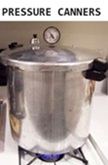
You can make jams, jellies, can fruit, applesauce, salsa and pickles with water bath canners, like this Granite Ware 12-Piece Canner Kit, Jar Rack, Blancher, Colander and 5 piece Canning Tool Set
